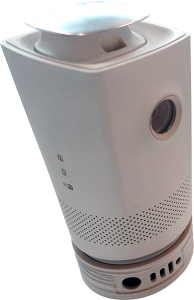We love celebrating great design, especially when our prints have been used to prototype and develop a product. We are very proud to have worked with Raymond Ng in the run up to his final degree show at Loughborough University where he presented .Lantern. By taking advantage of our student discount Raymond was able to utilise SLS 3D printing as a means of testing the feasibility and form of different designs, as well as producing the final prototype.

Overview
Simply put, .Lantern is an adaptable throw projector that redefines and replaces conventional AV systems. In addition to normal projection, with ultra short throw projection; Lantern can be placed extremely close to a wall and still project an image above 70″ eliminating the need to facilitate a TV in physical space.
Project Details
| CAD Design: | Provided by Raymond Ng |
| Material: | SLS Nylon |
| Polishing: | Yes |
| Dyeing: | No |
| Finishing: | All finishing by Raymond Ng |
| Project cost: | NDA |
The current consumer electronic market is saturated with technology that users don’t need (think 3DTV in recent times). .Lantern is a product that aims to encompass technology that users will value and realistically use.
Homes are getting smaller, and this facilitates adaptable technology suited to the user. This is why mobile devices and on demand content has become so popular, and .Lantern serves as a way of enabling this content in a sociable way.
Embracing I.O.T is an important part of the product, and serves as a sensible solution for the way users interact and connect with .Lantern. It also enables connectivity with existing apps and services in the market currently.
The physical space for user interaction, or lack of also validated the need to embrace wireless control and I.O.T. With digital content being provided by most mobile devices, the leap from viewing on mobile devices to using mobile devices as a control was a realistic and viable option that fit into the current eco-system of home entertainment products and apps.
Utilising 3D printing from 3DPRINTUK as a means of testing the feasibility and form of different designs, as well as producing the basis of the final aesthetic prototype. Due to the ‘blend’ between the quartic and round format, replicating this geometry for a vacuum formed shell was extremely difficult. The bases were also printed in SLS due to the complex geometry. The manufacturing choice is a 4 axis CNC routed part. But cost was a factor here, as the part would have required machine time worth over £500, which was not justifiable in the scope of the design prototyping phase.
